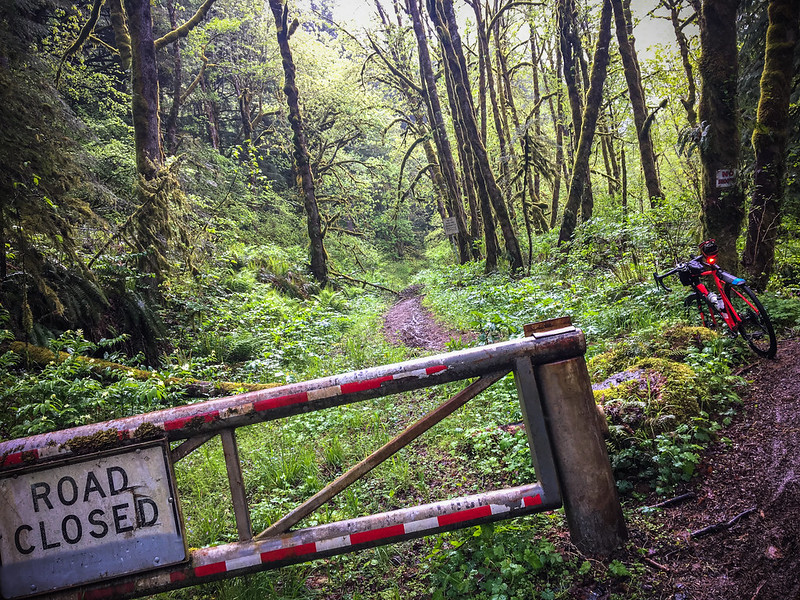
(Photos: J. Maus/BikePortland)
The Ride is brought to you by River City Bicycles.
Larch Mountain stands 4,061 feet above the Columbia River in east Multnomah County. The 14-mile climb up the paved road that leads to the summit of this extinct volcano is a thing of magic and/or misery for local bicycle riders.
But there’s another side of this majestic mountain. A side that was revealed to many people for the first time via The Dark Larch ride on Saturday.
The ride was the latest product of two of Portland’s most creative and enthusiastic bike adventure ambassadors: Our Mother the Mountain and Unpaved. Both of these entities are loosely organized online guides. They connect people with a passion for dirt and gravel roads with advice on routes, a calendar of group rides, an email list and other resources. It’s the same crew that brought us the Timber Logjam ride back in February.
The Dark Larch was a perfect example of their work. The route was in an area many people know well; but the trails and tracks were hidden. I smiled when my GPS computer reaad: “In 500 feet, turn left on ‘unknown trail'”. By sheer force of will, Ryan Francesconi (Unpaved), Ron Lewis (OMTM) and their team stitched together a tantalizing network of forgotten backroads, overgrown logging roads, and thin singletrack through thick forests. “How did I not know this was here!” I kept thinking to myself.
Advertisement
Saturday’s route of 50-miles and 5,400 feet of climbing was made all the more interesting due to incessant rain and near-freezing temps up on the high point of Larch.
From Dabney we headed east on the Historic Highway all the way to Latourell Falls on the well-worn Gorge tourist path. Then it was straight up for two miles on the wet dirt and rocks of Alex Barr Road. We then connected to Palmer Mill Road (which was “closed”) and a few secret trails through the forest before coming out at the Larch Mountain Road gate (at mile marker 8, the top section of the road is still closed for winter).
It was nearly freezing at the highest point of our route. And by then most of us were pretty soaked through (I rode from north Portland and had about 40 miles of wet riding already). With domestic commitments and mechanicals looming, I opted to roll just before the second half of the route.
Yes, I know I missed some of the best sections of the ride. I also know I’ll be back very soon.
Download the route and learn more at The Dark Larch on Ride With GPS.
— Jonathan Maus: (503) 706-8804, @jonathan_maus on Twitter and jonathan@bikeportland.org
BikePortland is supported by the community (that means you!). Please become a subscriber or make a donation today.


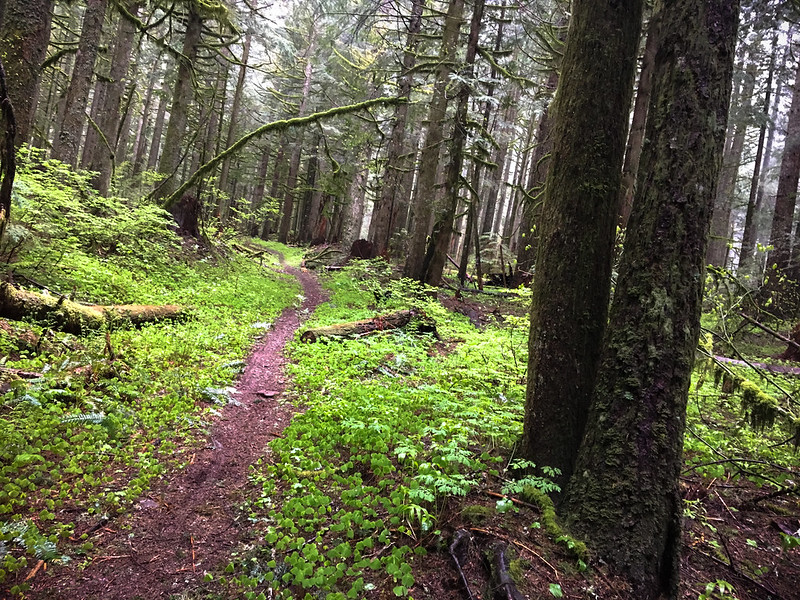
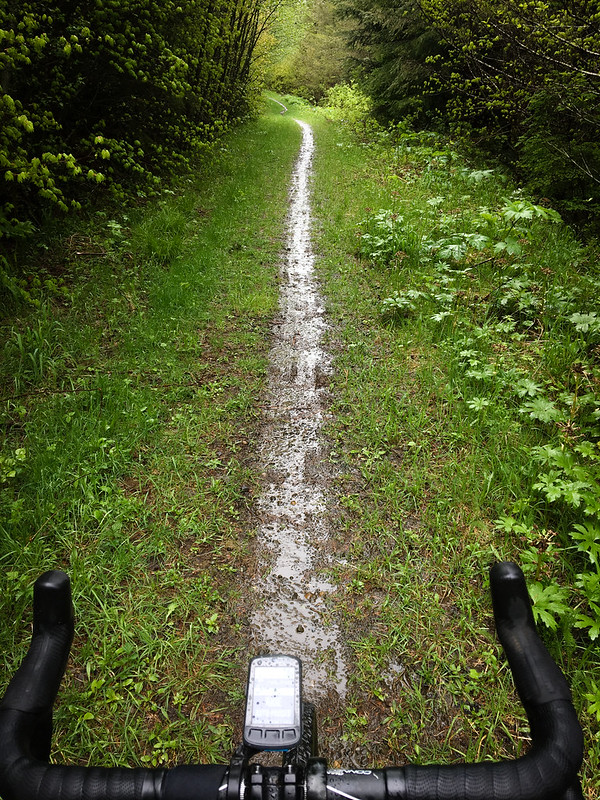
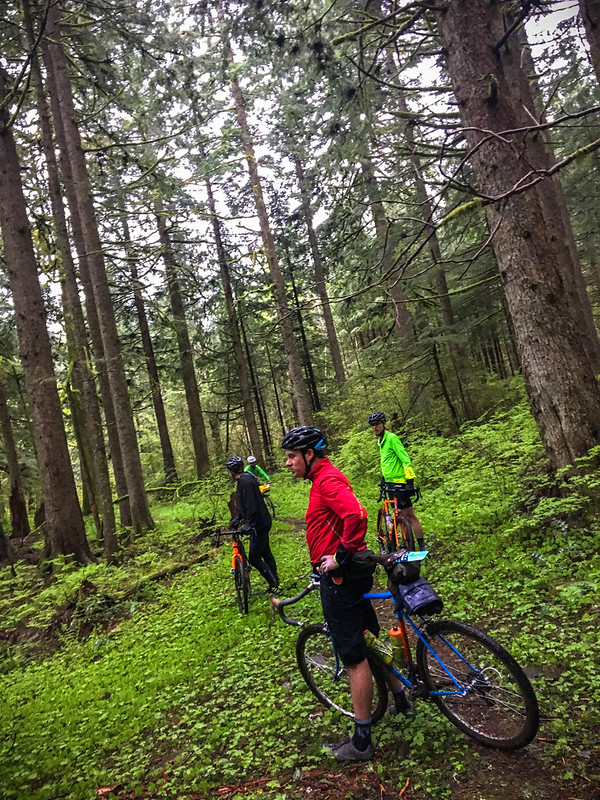
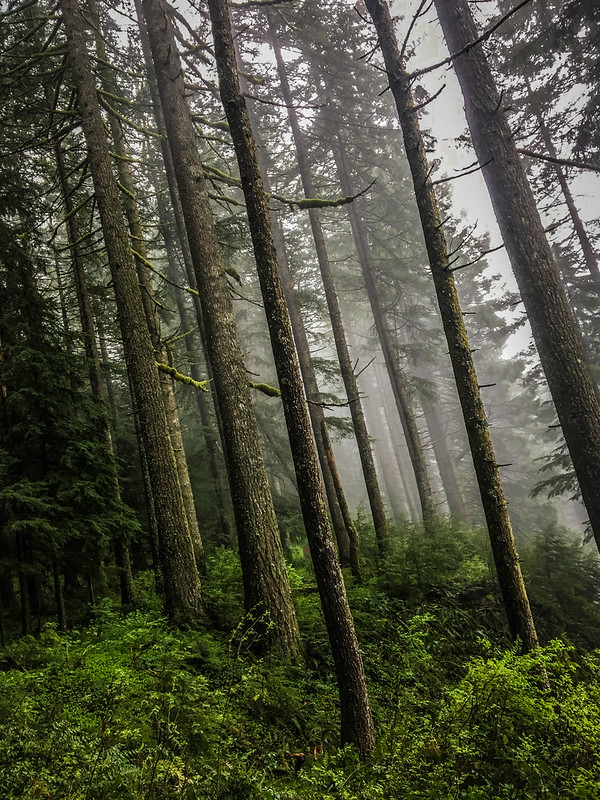
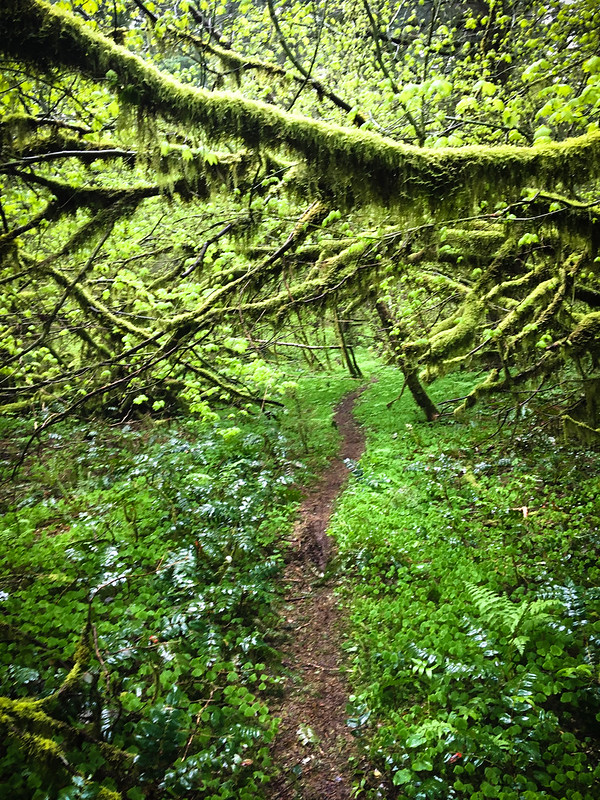
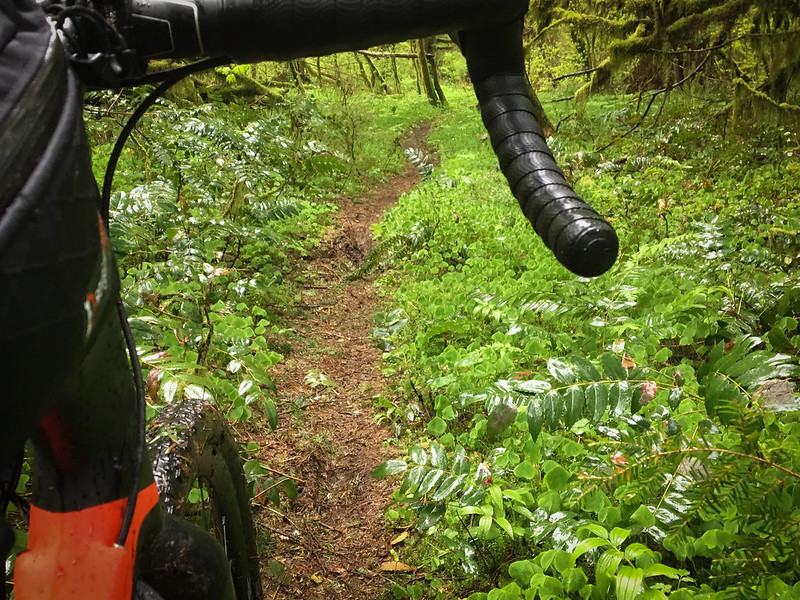
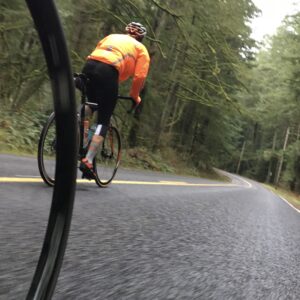
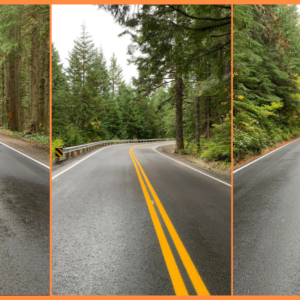
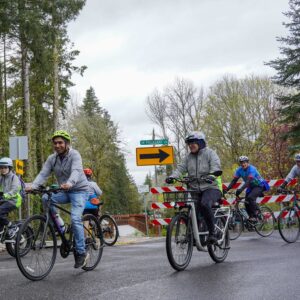

Thanks for reading.
BikePortland has served this community with independent community journalism since 2005. We rely on subscriptions from readers like you to survive. Your financial support is vital in keeping this valuable resource alive and well.
Please subscribe today to strengthen and expand our work.
Looks like a glorious ride. Too bad my beloved would never consent to such a route (she is a pavementarian and rides gravel and hard pack only under protest).
Nice turn of a word…”pavementarian”
Don’t I know that feeling. Our excursion up Palmer Mill on the pretext of having no traffic (unlike the climb to Vista Point) nearly ended it.
I took my cross bike for a small warmup ride on a rogue trail in Washington County park a couple of weeks ago. I got no more than 100 yards when I ran over a stick and it went up into my chain, wrapped around the pulleys on my derailleur, and snapped the derailleur off the bike. Broken derailleur and hanger. Had to walk back to the car. How do you prepare for this possibility when you are 20 miles or more away from help? Do you bring a spare derailleur and hanger with you when you ride?
Thankfully these kind of events aren’t too common, but this is why having a multi-tool with a chain breaker is a good idea. Remove junked gear, shorten chain, become a singlespeeder. Not ideal, but it gets you home. And the buddy system is always a good idea.
What Alan said. Mechanicals like that are pretty uncommon, and with the right tools you may be able to convert your bike to a singlespeed that might not work well, but with which you can limp home. I haven’t had my derailer get trashed by a stick on a ride, but I have had a stick damage a wheel, which is potentially as (or more) catastrophic.
And in that case, do you send the buddy home to bring you a new wheel? What happens next?
Call or text. (SMS may get out when voice does not.)
Carry/wheel out the bike.
Stash it and walk out. Come back with stuff to remove it.
Carry stuff to spend the night (fire starter, rain gear, poncho, mylar blanket, headlamp…).
Ride with a buddy in case it’s not the bike that breaks.
Leave word with someone about where you’re going and when you’ll check back in.
Just ideas; it’s good to prepare, but much more likely you’ll just have a great ride.
Mechanical failure is always possible. Many things can cause a bike to become unrideable: wheel or BB bearings can seize up. Wheels can break. Freehubs can go out. Chains can break. These things are all rare on a well maintained bike, but always possible.
You ALWAYS need to be prepared to walk out to a road where you could be picked up on ANY ride. The more remote the territory, the more important this becomes, because of the potential consequences, difficulty of rescue and possibility of no phone signal. That often means you need to carry the Ten Essentials just like smart hikers do, in case you need to survive out there a little longer than expected. Hypothermia is by far the #1 killer in the Northwest mountains. If you’re going into more remote territory you may also want to bring some extra clothes and food to shiver your way through a bivouac night. It’s never happened to me, but I’ve prepared for it lots of times. Not saying that would be necessary on this particular ride with a large group of people, but the Gorge seems to claim one or two lost hikers’ lives every year.
That’s a good idea, thx.
Hi dan,
I think about that often while riding in the muck and twigs. I’m constantly scanning ahead and I try to choose lines very carefully and am conscious of a light pedal stroke when going over twigs. But no, I don’t carry any spare parts. I usually don’t even have a chain tool w me.
I was aware that I was riding over some branches, and was going slower than walking speed when it happened to me. I’d really like to try some of this adventure riding that you’ve been sharing with us, but things like this make me a tad nervous. Be careful out there! 🙂
Make sure you are wearing shoes you can walk out in.
I broken 3 chains, 2 road riding/ commuting, and 1 mountain biking. A Chain tool is a must if you want to get home. Crankbrothers has a great multi tool with a chain tool on it. Buy it. You’ll be glad you have it when your chain goes south.
I’ve
This actual happened to Ryan during this ride. He had an extra hanger, which is a great idea, and got it sorted out(along with a trail fairy/riding buddy assist). Point being you definitely want extra schtuff and should be prepared for these rides. Food, GPS, tubes, mechanical stuff, and water.
I busted a wheel on a ride to work a couple of years ago, and waited an hour for my wife to pick me up. I was wearing an extra layer (tights and a long sleeve top), but by the time she picked me up I was physically shivering. I have no idea what I would do if I had to unexpectedly spend the night in the woods in that gear. I don’t think ‘riding carefully’ is the same thing as being prepared. You should definitely have survival gear with you.
This is one of the reasons that internal gear hubs are not uncommon on ‘adventure’ type bikes.
Crazy things happen, but they’re pretty rare. I was tooling around with my mtn bike a block from home when a missed-shift kicked the chain into that little gap between the cassette and the spokes. Broke *8* of ’em. Extreme bike rides through mud and gravel and sticks and rocks (hit a rock so hard once it bent my big chain ring, yikes) never broke the bike to be unrideable. Bring the stuff that makes sense on the shorter rides (ex: tubes, pump, patches, multi tool) and bring more stuff for the distance (ex: spare folding tire). I do like the idea of bringing the chain breaker brought up in this thread. That + adjusting the derailleur would definitely get you home in your situation. Not the best deal, but what can you do?
Yes, I always carry a spare hanger with me. I have had to swap out a broken hanger twice. Once in the middle of nowhere on the Oregon Outback route on the back side of the Ochoco mountains.
Yikes, that’s some pretty bad luck losing a derailer hanger twice on a single ride. But then again, a few years ago I got THREE flats on the Dalles Mountain 50. I had two spare tubes (and regrettably, no patch kit), so I ended up walking the last 5 miles back into town. Things happen.
yes. always.
Hey Jonathan – looks like you caught us in one of your pictures up there. We didn’t realize it was you until after you had passed. The trails and logging roads on the latter half of the route were great, you’ll have to get out there for the rest of the route sometime.
I’ve managed to get out for three of the OMTM rides so far this year, and they have all been fantastic. If you enjoy riding on unpaved roads/trails you’ve got to check their stuff out. Get out on one of their many published routes, or better yet, join in on one of their upcoming rides. Seems like about 50 people (more or less) have been showing up, and everyone is super friendly. Here’s my recorded ride for the Dark Larch with some additional photos: https://ridewithgps.com/trips/14553947
Hi zack!
That was your group in the woods?! Funny. I think it’s awesome how RWGPS is so supportive of this type of riding. You guys rock.
I’ve done that palmer mill to milepost 8 road on a road bike in the summer. Its deep. This route looks fantastic.
Larch Mountain is also good on foot. Start at Multnomah Falls. About 4k gain and 7 miles one way. Awesome walk along the creek for at least the first half. I think you could also start at Oneonta Gorge or Horsetail Falls – can’t remember how those are for distance.
50 miles with extreme potential of getting lost in driving rain and freezing temperatures. You need your heads examined.
It’s the things you don’t do you’ll regret the most.
Hats off to OMTM and Unpaved. Not only did they come up with this great route, they obviously invested hours scouting and clearing sections to make them rideable. These kind of rides add an element of adventure that I have come to love. While there is the possibility of getting lost or stranded, I feel so much safer out there without cars then on any road in Portland. I carry a small survival kit and bring enough tools and parts for emergency roadside repair. While not for the faint of heart these routes can be enjoyed by many, including at least 2 of us out there who were over 60. Last month I flatted while riding Japanese Hollow, 2 middle aged woman in an SUV stopped and chatted with us for 15 minutes offering us help or a ride into the Dalles if needed. How often does that happen on Portland?
Hmm, that’s ironic.
Haha, just reread my post, cars or no cars…… I was trying to explain that auto traffic is minimal on these routes and it’s a different breed of driver out there. When I encountered people on the Japanese Hollow route, whether in a pickup, or just out in their yard, I waved to everyone of them and the vast majority smiled and waved back. Hard to explain but for me these kinds of rides are what makes cycling so great. Beauty, adventure, challenge, and some of the best people, both riding and along the route.
Yeah, understood. I’d love to start getting into this stuff and get out of riding Skyline all the time, but I almost always ride solo, so I have serious concerns about going off the grid where my wife (or a kind stranger) wouldn’t be able to hear from me, locate me or drive out to pick me up. I have no doubt that the riding itself is great.
Dan,
You can use a product like SPOT satellite messenger or carry an InReach phone for reassurance in remote locations without cell service. I always have a space blanket, plastic poncho, waterproof matches and small first aid kit with me on rides like this. There’s a lot of good information out there about preparing for a remote bicycle ride and no reason not to get out and explore a bit.
Dan, +1 on what Bobcycle said about carrying extra stuff. As the other 60+ rider I also carry a Spot that might help in a pinch. I would encourage you to tryout these rides, they are awesome compared to all the time road rides. I too usually ride solo. Even though I’m as slow as anyone out there, you still see others once in awhile.
I thought one of the basic tenets of ethical off-road riding was staying off trails when they are muddy.
Depends on the tread surface, the use, and the environment. Forest duff can handle wet riding, clay (not at all). These trails (roads) see so little use that wet riding is not a problem.
yep that’s generally true. But like the other commenter says, context matters. In this case the forest trails showed very little impact from the bike traffic. nothing more than you’d see from a hiking boot.
I hear you, but call BS on that reply. The trail pictured is obviously not fit for riding. Saying that it is OK because there are few riders is a specious argument. Just the writing of this article will what, double, triple the usage of that trail? Sounds like ‘do as I say, not as I do’.
I also see no reason a ride like this could not be postponed for a month…
The trails need to dry out. If a few people want to do it, fine, but advertising it is not the right thing to do. Think what another 20 or 30 bikes will do to the trail photos you posted…
Think Cyclocross.
actually.. this ride was already postponed 2 months for this very reason. It was supposed to happen in March. Unfortunately it was a wet day – but the trails will be fine.
In many parts of the country (including MN, where I am now), wet riding is absolutely off limits, but not in the Northwest. Lots of NW trails are considered OK to ride when wet. Depends on the soil type and amount of traffic.
Sandy Ridge is a great example of a trail that is 99% ride-able when wet. Its the flat, non contoured, non reversed grade trails that get destroyed. Also, the Sandy Ridge group is always giving trail conditions updates to advise when to ride based on conditions. Traffic, either foot or bike, on wet clay creates issues when combined with poor trail design. This is why the wild wood trail is a sh#t show in the winter) and why it is so muddy. People impact trails differently depending on design. The trails shown in the pics are actually reclaimed FS/ logging roads with a rock bed with forest duff on top. It drains great, and riding when wet is not an issue. The forest has grown in creating singletrack. One must ask themselves if they also avoid hiking and trailrunning when wet. My experience on Holman lane tells me that’s a definite NO.
I am an avid hiker, as well as cyclist. Hikers are much more adverse to hiking in slop than cyclists. It slows you down dramatically, gets you covered with muck, and is just no fun. Cycling on muddy trails is still a blast, though. Not to say that some hikers do not head out into slop, but most avoid it. They will sometimes do the same damage as bikes, though, starting a new drier track next to the slop. That is the real harm. I think hikers who stay in the slop do a lot less damage than bikes, because they don’t dig down very deeply and their weight is distributed over a much larger area than the tiny footprint of a tire (especially a cross tire).
The trail around Hagg Lake, Angel’s Rest in the Gorge, and Wildwood shows me otherwise.
Would someone clarify the legality of riding off road in this area? I though it was not allowed, especially when it’s wet and muddy.
Thanks
Rando,
We rode on all legal and open/accessible trails. There is no law about “wet and muddy” and we didn’t cut any new trails or do any damage to any sensitive areas that the existing trail didn’t already do when initially cut in.
Does biking have an impact on these areas? Absolutely. So does hiking, driving, hunting, fishing, mushroom-searching, cutting wood, and so on.
Cyclists doing these sorts of rides need to learn (or think in terms of) other outdoor disciplines that are well-versed in how to survive in the outdoors. Mountaineers, climbing, backpacking all focus on always carrying at least the “10 Essentials” and planning for the weather and elevation you’ll be at. In weather like this, at altitudes on Larch, from which you’ll be descending at speed, you’re gonna get cold.
In this kind of ride, you need to be prepared which means carrying more stuff which is counter to how cyclists usually think (in terms of lowering weight and carrying as little as possible). The good news is that we all probably own a backpack, and there are endless more-comfortable options for carrying stuff like baskets, frame bags, and big-ass handlebar bags. Bring the 10 essentials, extra clothes, extra food, a space blanket (I’ve hauled along an ultralite bivvy on a couple solo rides), etc.
I am an avid hiker, as well as cyclist. Hikers are much more adverse to hiking in slop than cyclists. It slows you down dramatically, gets you covered with muck, and is just no fun. Cycling on muddy trails is still a blast, though. Not to say that some hikers do not head out into slop, but most avoid it. They will sometimes do the same damage as bikes, though, starting a new drier track next to the slop. That is the real harm. I think hikers who stay in the slop do a lot less damage than bikes, because they don’t dig down very deeply and their weight is distributed over a much larger area than the tiny footprint of a tire (especially a cross tire).
Then there’s the matter of riding on privately owned timberlands which in recent times have required permits for access. We left Larch Mountain Rd. on a single track trail that dumped us onto a dirt road. As I entered back onto paved public roads, going around a gated access point, I saw a sign stating no access without a permit. This is similar to the experience we had on the Timber Logjam. Jonathan, I know you cut your route short and may have missed this part but the “permit required ” kind of makes me uncomfortable. What are your thoughts on this?
I rode this yesterday. I started at the Troutlets. What a great route!!! Oxbow was a bit overgrown and had many downed trees otherwise it was great. I did it on 2.1″ tires and it was great. Made the single track very doable. It will be even better when the road to the top of Larch is open. Going to the viewpoint at the top will be a great addition. I will be doing this one again. Great job coming up with an amazing diverse ride!